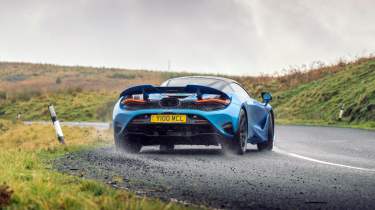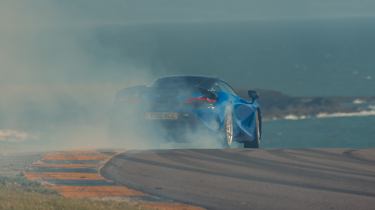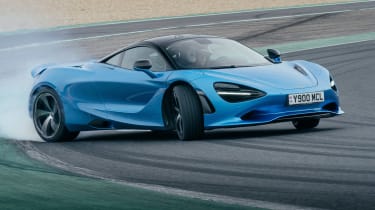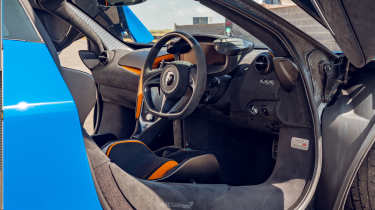McLaren 750S 2025 review – less weight and more aggression for Woking’s blistering Ferrari 296 GTB fighter
McLaren’s 750S is an evolution of the 720S it replaces, cherrypicking choice parts of the wild 765LT to create a McLaren best-of album on four wheels
After the turmoil of launching its first hybrid supercar, the Artura, McLaren has kept things simple when it comes to the 750S, the replacement for its smash hit 720S supercar. Instead of incorporating a complex hybrid powertrain, they’ve cherry picked the best of 765LT and blended it with detail changes, on top of everything that made the 720S great.
Its relative simplicity has become a novelty in the class, what with Ferrari’s 296 GTB using a hybridised V6 and the Lamborghini Temerario bringing over 900bhp, thanks to its electrically-augmented 10,000rpm V8.
It’s still a standard-setter, though. To the tune of getting an instant invite following its 2023 launch to that year’s evo Car of the Year test, where it faced 2023’s best of the best driver's car, including Porsche's 911 GT3 RS, Alpine A110 R, BMW M3 CS to name but a few. Towards the end of 2024 it faced the GT3 RS again in a lap time battle around the Anglesey Circuit, in a battle of raw power against precision and downforce, with intriguing results. We threw a Radical and a Revolution race car in for a bit context (and why not?).
Engine, gearbox and technical highlights
In terms of design, McLaren calls it a comprehensive facelift rather than an all-new car, which for some will still be stretching it. The changes are subtle. So subtle that you might need a McLaren designer with you when you’re pointing out the changes to your mates.
More reviews
There’s an extended front splitter, the front bumper is lower and the openings in the distinctive eye-socket headlights have been tweaked to improve gearbox and charge cooler airflow. There are also a new pair of rear wheel arch vents, with the rear tyres more exposed to reduce pressure within the arches.The biggest change is the larger extended rear wing from the 765LT, with a 20 per cent increase in surface area and a 1.6kg reduction in weight. As with the LT, the active wing features a cutout to prevent heat damage and improve rearward visibility.
There’s more power from the 4-litre V8, peaking at 740bhp (because we all know a 720S needed more power). That's partly thanks to a rise in boost pressure, while the 765LT’s lighter, stronger pistons have been slotted in along with a high-flow fuel pump, a triple layer head gasket and an ECU map to manage it all. The M840T now sits on bespoke engine mounts, too, claimed to enhance the sound and feedback to the driver. Completing the powertrain upgrades are the 765LT’s shorter gear ratios.
Performance and 0-62 time
What an engine! The V8 delivers a fevered performance, its appetite for revs insatiable. It’s not a particularly musical powerplant, but it’s devastatingly effective. Such are the explosive gusts of turbocharged thrust, it’s slightly tricky to work up a flow with it – squeeze the throttle, boom!, you’re a hundred metres away from where you were just a blink ago, so you back off, take a breath, and repeat…
It can be tricky converting all that power into forward momentum when the wheelspin flares every time you hit a ridge. And all the while the steering stays eerily calm, and you have the feeling of being right at the pointy end of a ground-skimming fighter plane.
Yes, it lacks the sonorous qualities of the (dearly departed) Lamborghini V10 (and perhaps even the Ferrari twin-turbocharged V6), but the M840T hits so hard and the way it builds in intensity right to the limiter is unique and extremely exciting. On track the more exaggerated upshift thump in Sport mode isn’t really helpful and can upset the balance of the car (and cause traction issues in the wet), but Track is much more effective.
A great 750S attribute is its consistency of performance. Where even the mighty Ferrari 296 GTB needs a battery-depleting ‘Qualifying’ mode to gives it maximum, the McLaren is always running full power and has a power-to-weight advantage, too.
Ride and handling
It speaks volumes for the 750S that it rewards rather than frustrates on the road. Opening the throttle to its stop is almost impossible and feeling the 4-litre twin-turbocharged V8 rush through more than a single gear seems a far flung fantasy. Yet the driving environment, the quality of the steering, the sheer sense of occasion and the high-quality dynamics elevate any road drive to something out of the ordinary.
There’s a fluidity and suppleness to the ride, but it’s not as magic carpet as a 720S, and the softer front springs (by three per cent) and stiffer rears (four per cent) add an edge to the 750S. Not a jarring one, but one that reminds you that this is a tighter, more characterful McLaren. New geometry and changes to the damper settings, which are part of the company’s third generation Proactive Chassis Control, complete the upgrades.
The 765LT’s chassis hardware only builds on the 720S’ ability. Its steering, still hydraulic, still buzzing between your fingers as it encounters every surface, has a degree more weight around the straight ahead, but less kickback and is more direct as a result. Over any surface it remains measured and beautifully linear, the rate of response inspiring in a world of over-servoed EPAS systems.
I resolve to really take in every moment and try to feel every subtle difference between the 750S and the car it replaces. And yet the 750S has other ideas. Whilst I pondered steering response and feedback in the pit lane and wanted to get a handle on throttle response as compared to hybrid rivals, the reality of driving a 740bhp supercar on an awesome, old-school track on sticky tyres takes you to other places. Meticulous analysis can’t escape the awe. Conscious thought gives way to instinctive actions and reactions.
It’s only when the laps are over that you can start to unpick the narrative. And the fact that the 750S becomes so all-consuming to drive is mostly due to its fluidity, consistency and the fact it displays such fine balance. Cars that really make you think are usually putting barriers in the way. McLaren has instead created a car that seems to offer unfettered access to its vast performance. It’s a real achievement and its rooted in the core qualities that this car holds so dear and that seem more and more precious as we march towards hybridisation and full EVs.
So, yes, with the benefit of hindsight, the natural attributes of the 750S shine extremely brightly on track. Primarily the sheer performance on offer – it really is something to behold when you can let it run through several gears – and the easy balance it displays even under duress.
The steering – faster than before but still much more measured than the 296 – is gorgeous. There’s more heft to it than in the 720S but the thin-rimmed steering wheel still imparts a sense of delicacy and is alive with feedback. Perhaps that means the staggering agility of the Ferrari remains just out of touch. However, as we found on the road, the McLaren feels more natural and more linear in its responses. The first stint on track is completed in damp conditions and so the fact that the 750S lets you lean into the grip is a very welcome trait. Even so that mighty engine requires care. It will easily spin-up the rear wheels in, say, 4th gear when the surface isn’t completely dry.
McLaren brakes are a source of some disagreement around these parts. I love the pedal placement and the slightly long travel because it encourages and rewards left foot braking. Barker and Meaden, on the other hand, don’t like the fact that you’re almost forced to drive with both feet. The 750S won’t bring the two sides of the argument much closer together… The new brake booster and additional vacuum pump do create a slightly firmer pedal but it’s still a world away from a Porsche system and still feels engineered primarily for left-foot braking. At Estoril the optional track-spec braking package shows strong endurance, though. Helped, of course, by the low kerb weight. I can’t imagine a world where you wouldn’t specify the optional Senna-derived braking package, simply because the 750S is so fast that it needs all the stopping force it can get.
Approaching the limit of grip, the 750S still tends towards gentle understeer and is certainly less pointy than the 296. However, there’s a calm, locked-down feel that’s a notable step-up from the 720S. And with 740bhp you don’t have to accept understeer should you want to bring the rear into play. In fact, just selecting Track for the Handling mode is a huge help here, allowing you to input a slightly faster turn-in phase to excite the rear and then enjoy a very neutral balance. Stay committed to the throttle and the 750S is wonderfully controllable as it starts to oversteer and such is the power available that you can really tease and steer the car accurately in this manner. The lack of a mechanical limited-slip differential is very rarely felt.
Hook everything up and the 750S eats-up Estoril. There’s not quite the surreal, manic nature of the 765 LT but it’s pretty close, and it retains the lovely split personality of the 720S. Drive it neatly and the 750S is blindingly fast and predictable but there’s the scope to really attack and feel it come to life as it demands more input and fast hands. Either approach is a huge thrill and the Trofeo R tyres really up the ante.
A 720S always felt limited by its more conservative tyre choice on track and it’s great to see that’s been rectified. Simple, transparent and yet endowed with massive performance, the 750S is no revolution, but remains very special in its own right.
Interior
Before you even get going the cabin remains a work of wonder, planting you in the heart of the action, plugging you into the MonoCell carbon tub. There’s no rotating dial pack, which is a shame, as the Artura’s fixed instrument binnacle feels a step down.
That also means the drive mode controls are no longer set into the centre console stack, but as two semi-rotating controls on either edge of the binnacle. The hybrid car’s infotainment system is also fitted and works, which is a huge step up.
Price, rivals and used alternatives
The McLaren 750S is a result of iteration, rather than nut-for-bolt revolutionary change. As such, its most important rival is the excellent, eCoty-winning 720S that it’s here to replace. The 750S improves on the 720S in all subjective areas, if perhaps not in terms of absolute ride comfort but then again, all proactive chassis McLarens ride inordinately well for supercars. Nevertheless, a 720S for less than £120k will always remain a tempting alternative given the value proposition, at more than £100k cheaper than a 750S.
Contemporary rivals from other manufacturers are few at the moment, with the Ferrari 296 GTB probably closest in terms of performance potential and price. It’s a lot heavier and falls behind in terms of steering feel compared to the McLaren. There’s something to be said for the appeal of the McLaren’s relative simplicity, too. Lamborghini returns to this high-end supercar space this year, with the Temerario and its electrically augmented 10,000rpm V8, good for over 900bhp. Gone are the days of the Huracán and its slightly apologetic top trump numbers. You need to look further afield for all-motor alternatives, like Maserati's MC20 and Aston Martin's Vantage. There are also the Aston Martin Vanquish and Ferrari 12 Cilindri, though they're much softer experiences and a lot more money.
McLaren 750S specs
| Engine | 4-litre twin-turbocharged V8 |
|---|---|
| Power | 740bhp |
| Torque | 590lb ft |
| Weight | 1389kg (DIN) |
| Power-to-weight | 533bhp/ton |
| 0-62mph | 2.8sec |
| Top speed | 206mph |
| Price | From £250k |









